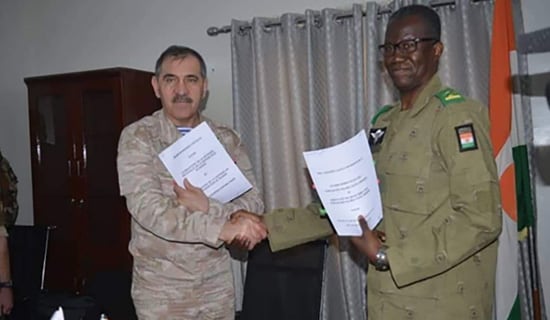
Former Indian Army chief General V. P. Malik
In a recent article, former Indian Army Chief General V. P. Malik called upon India to beef up its military preparedness in view of China's growing military presence in Pakistani Kashmir along the Line of Control (LoC), which divides Kashmir between Pakistan and India. Malik's article comes after Lt.-General K. T. Parnaik, chief of the Northern Command of Indian Army, warned in early April 2011 that India faces a threat from the Chinese troops in Pakistani Kashmir.
There have been reports of more than 11,000 Chinese troops being stationed in Gilgit Baltistan, an ethnically distinct region that has traditionally been considered as part of Pakistani Kashmir. But now, Indian intelligence reports confirm that Chinese are also inside Pakistani Kashmir along the LoC. Lt.-Gen. Parnaik said: "we hear many people today who are concerned about the complicity of the Chinese if there were to be hostilities between India and Pakistan... Not only because they are in the neighborhood but the fact that they are actually stationed and present on the LoC."[1]
In his article, General V. P. Malik noted that China and Pakistan are articulating a "joint interest" vis-a-vis India, and close cooperation between their militaries poses a threat to India's security. He wrote: "Though the Chinese army would not point guns towards our posts on the LoC, the fact that they are there reflects their 'joint' interest and enhancement of strategic and operational preparedness on the LoC along with Pakistan."
Following are excerpts from the article:[2]
"It is Also Known that China Plans to Construct a Railway Line and Oil Pipelines from Kashgar in Xinjiang to Gwadar Port in Pakistan"
"Two years ago, a ministry of defense (MoD) report had stated that 'the possibility of China and Pakistan joining forces in India's farthest frontiers [in Kashmir], illegally occupied by the two neighbors, would have direct military implications for India.' That possibility is now a reality...
"[In early April 2011] the Northern Army Commander (NAC) confirmed that Chinese troops are present on the Pakistani side of the Line of Control (LoC) [which divides Kashmir between Pakistan and India].
"Though the Chinese army would not point guns towards our posts on the LoC, the fact that they are there reflects their 'joint' interest and enhancement of strategic and operational preparedness on the LoC along with Pakistan.
"What the NAC has stated is not new. The Chinese military presence in the Gilgit-Baltistan area of Pakistan-Occupied Kashmir (PoK), purportedly to improve infrastructure, became visible last year.
SUPPORT OUR WORK

"It is also known that China plans to construct a railway line and oil pipelines from Kashgar in Xinjiang to Gwadar port in Pakistan."
"With an Assertive China, the Dispute over Accession of... [Kashmir] to India is No Longer a Bilateral Issue between India and Pakistan..."
"Another development needs to be linked to this issue. The MoD notes that the Sino-Indian border is 4,056-km long and includes the whole of the western sector including Aksai Chin, PoK, and the Shaqsgam Valley (ceded by Pakistan to China in an India-disputed agreement in March 1963).
"But in a statement [in] a Chinese newspaper in 2010, the Indian ambassador to China put the border length to be 3,488 km. The Chinese newspaper added its own comment along with the interview: 'There is no settled length of the common border. The Chinese government often refers to the border length as being about 2,000 km.'
"Now, the Chinese [newspaper] has made this figure (2,000 km) the new norm in the official characterization of the border with India. It appears to have knocked off almost the whole of the western sector boundary and has questioned Indian sovereignty over J&K [Jammu & Kashmir].
"With an assertive China, the dispute over the accession of J&K to India is no longer a bilateral issue between India and Pakistan, but a trilateral issue among India, Pakistan, and China. It has thus ensured integrity, authority, and security over Aksai Chin and the Shaqsgam Valley held by China."
"In the Coming Financial Year, China Plans to Spend $91.6 Billion on Defense, and this Does Not Include Its Budget for Internal Security"
"While planning for the north-western sector [Pakistan and China], the Indian armed forces have no alternative but to factor in the two-pronged threat. It is now obvious that as China develops, it will become more aggressive and create new pressures on the border issue.
"China is known to be assertive in its diplomacy on security and military issues. It will attempt to exploit our diplomatic appeasement postures and defense weaknesses on the ground to its advantage.
"India cannot afford to let the latest developments go uncontested diplomatically. In the interest of its own security and Asian stability, it must build a sympathetic international lobby.
"In the coming financial year, China plans to spend $91.6 billion on defense, and this does not include its budget for internal security. India's approved defense budget this year is $34 billion.
"India must pay greater attention to its defense preparedness, particularly on the northwestern borders. There's an urgent need to build defense infrastructure along the northern border.
"According to media reports, our border road-building programs in the north are three years behind schedule. Aside fom making up shortages and replacing obsolescent weapon systems with newer ones at the earliest, we must build rapid reactive military capability for all under-developed areas in the Himalayas.
"India must not become complacent, as we did before 1962 [war with China]."
Endnotes:
[1] www.timesofindia.com (India), April 6, 2011.
[2] www.hindustantimes.com (India), May 12, 2011. The text of the article has been mildly edited for clarity.




